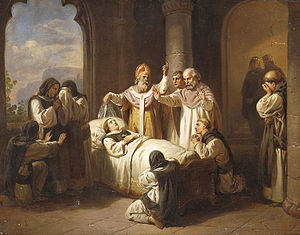Margaret of Hungary (saint)
Saint Margaret of Hungary, O.P. | |
|---|---|
 "The Death of Saint Margaret" by Jozsef Molnar (1857) | |
| Nun and Virgin | |
| Born | January 27, 1242 Klis Fortress, Klis Kingdom of Croatia |
| Died | January 18, 1271 (aged 28) Nyulak Szigete Kingdom of Hungary |
| Venerated in | Roman Catholic Church (Dominican Order) |
| Beatified | July 28, 1789 by Pope Pius VI |
| Canonized | November 19, 1943 by Pope Pius XII |
| Feast | January 18 |
| Attributes | A lily and a book |
Saint Margaret, O.P. (January 27, 1242 – January 18, 1271) was a Dominican nun and the daughter of King Béla IV of Hungary and Maria Laskarina. She was the younger sister of St. Kinga of Poland (Kunegunda) and the Blessed Yolanda of Poland and, through her father, the niece of the famed Saint Elizabeth of Hungary.
Life
Margaret was born in Klis Fortress in the Kingdom of Croatia, the eighth and last daughter (9th of 10 children) of the royal couple. They resided there during the Mongol invasion of Hungary (1241–42) as her father was also ruler of this land.[1] Her parents vowed that if Hungary was liberated from the Mongols, they would dedicate the child to religion.
The four-year-old Margaret was entrusted by her parents to the Dominican monastery at Veszprém in 1245. Six years later she was transferred to the Monastery of the Blessed Virgin founded by her parents on Nyulak Szigete (Rabbit Island) near Buda (today Margaret Island, named after her, and a part of Budapest; the ruins of the monastery can still be seen). She spent the rest of her life there, dedicating herself to religion and opposing all attempts of her father to arrange a political marriage for her with King Ottokar II of Bohemia. She appears to have taken solemn vows when she was eighteen years old. In marked contrast to the customs of her Order, she received the Consecration of Virgins along with some other royals to prevent further attempts on the part of her father to have her vows dispensed by the Pope for marriage.
Many of the details of her life are known from the Legend of Saint Margaret, written probably in the 14th century and translated from Latin to Hungarian in the 15th. The only remaining copy of the legend is in the Margaret Codex copied by the Dominican nun Lea Ráskay around 1510. According to the legend, Margaret chastised herself from early childhood, wore an iron girdle, hairshirts and shoes spiked with nails. She later also performed the dirtiest tasks in the monastery.
Veneration
She was venerated as a saint soon after her death, e.g., a church dedicated to her in Bocfolde, Zala County, appears in documents dated 1426. Steps were taken to procure her canonization shortly after her death, at the request of her brother King Stephen V. The necessary investigations were taken up between 1271 and 1276, but the canonization process was not successful, even though seventy-four miracles were ascribed to her intercession, most of them referring to curing illnesses, even someone coming back from the dead. Among those giving testimony were twenty-seven people for whom miracles had been wrought. Unsuccessful attempts to canonize her were also made in 1640 and 1770. She was finally canonized by Pope Pius XII on 19 November 1943, at that time the feast day of her aunt, Saint Elizabeth of Hungary.
Her feast day is celebrated by the Dominican Order. Raised by Pope Pius VII to a festum duplex, it is the day of her death, January 18.
Her monastery was among those suppressed in 1782, part of the suppression of all monastic Orders by the Emperor Joseph II. At that time, her remains were given to the Poor Clares. They were kept in Pozsony (today Bratislava) and Buda. The relics were partly destroyed in 1789 but some portions were preserved and are now kept in Esztergom, Győr, and Pannonhalma.
In art Margaret is usually depicted in a Dominican nun's religious habit, holding a white lily and a book.[2]
Ancestry
| Family of Margaret of Hungary (saint) | ||||||||||||||||||||||||||||||||||||||||||||||||||||||||||||||||||||||||||||||||||||||||||||||||||||||||||||||||||||||||||||||||||||||||||||||||||||||||||||||||||||||||||||||||||||||||||||||||||||||||||||||||||||||||||||||||||||||||||||||||||||||||||||||||||||||||||||||||||||||||||||||||||||||||||||||||||||||||||||||||||||||||||||||||||||||||||||||||||||||||||||||||||||||||||||||||||||||||||||||||||||||||||||||||||||||||||||||||||||||||||||||||||||||||||||||||||||||||||||||||||||||||||||||||||||||||||||||||||||||||||||||||||||||||||||||||||||||||||||||||||||||||||||||||||||||||||||||||
|---|---|---|---|---|---|---|---|---|---|---|---|---|---|---|---|---|---|---|---|---|---|---|---|---|---|---|---|---|---|---|---|---|---|---|---|---|---|---|---|---|---|---|---|---|---|---|---|---|---|---|---|---|---|---|---|---|---|---|---|---|---|---|---|---|---|---|---|---|---|---|---|---|---|---|---|---|---|---|---|---|---|---|---|---|---|---|---|---|---|---|---|---|---|---|---|---|---|---|---|---|---|---|---|---|---|---|---|---|---|---|---|---|---|---|---|---|---|---|---|---|---|---|---|---|---|---|---|---|---|---|---|---|---|---|---|---|---|---|---|---|---|---|---|---|---|---|---|---|---|---|---|---|---|---|---|---|---|---|---|---|---|---|---|---|---|---|---|---|---|---|---|---|---|---|---|---|---|---|---|---|---|---|---|---|---|---|---|---|---|---|---|---|---|---|---|---|---|---|---|---|---|---|---|---|---|---|---|---|---|---|---|---|---|---|---|---|---|---|---|---|---|---|---|---|---|---|---|---|---|---|---|---|---|---|---|---|---|---|---|---|---|---|---|---|---|---|---|---|---|---|---|---|---|---|---|---|---|---|---|---|---|---|---|---|---|---|---|---|---|---|---|---|---|---|---|---|---|---|---|---|---|---|---|---|---|---|---|---|---|---|---|---|---|---|---|---|---|---|---|---|---|---|---|---|---|---|---|---|---|---|---|---|---|---|---|---|---|---|---|---|---|---|---|---|---|---|---|---|---|---|---|---|---|---|---|---|---|---|---|---|---|---|---|---|---|---|---|---|---|---|---|---|---|---|---|---|---|---|---|---|---|---|---|---|---|---|---|---|---|---|---|---|---|---|---|---|---|---|---|---|---|---|---|---|---|---|---|---|---|---|---|---|---|---|---|---|---|---|---|---|---|---|---|---|---|---|---|---|---|---|---|---|---|---|---|---|---|---|---|---|---|---|---|---|---|---|---|---|---|---|---|---|---|---|---|---|---|---|---|---|---|---|---|---|---|---|---|---|---|---|---|---|---|---|---|---|---|---|---|---|---|---|---|---|---|---|---|---|---|---|---|---|---|---|---|---|---|---|---|---|---|---|---|---|---|---|---|---|---|---|---|---|---|---|---|---|---|---|---|---|---|---|---|---|---|---|---|---|---|---|---|---|---|---|---|---|---|---|---|---|---|---|---|---|---|---|---|---|---|---|---|---|---|---|---|---|---|---|---|---|---|---|---|---|---|---|---|---|---|---|---|---|---|---|---|---|---|---|---|---|---|---|---|---|---|---|---|---|---|---|---|---|---|---|---|---|---|---|---|---|---|---|---|---|---|---|---|---|---|---|---|---|
| ||||||||||||||||||||||||||||||||||||||||||||||||||||||||||||||||||||||||||||||||||||||||||||||||||||||||||||||||||||||||||||||||||||||||||||||||||||||||||||||||||||||||||||||||||||||||||||||||||||||||||||||||||||||||||||||||||||||||||||||||||||||||||||||||||||||||||||||||||||||||||||||||||||||||||||||||||||||||||||||||||||||||||||||||||||||||||||||||||||||||||||||||||||||||||||||||||||||||||||||||||||||||||||||||||||||||||||||||||||||||||||||||||||||||||||||||||||||||||||||||||||||||||||||||||||||||||||||||||||||||||||||||||||||||||||||||||||||||||||||||||||||||||||||||||||||||||||||||
References
- ^ "Klis –vrata Dalmacije" (PDF). Građevinar (in Croatian). 53 (9). Zagreb: Croatian Society of Civil Engineers: 605–611. September 2001. ISSN 0350-2465. Retrieved 2009-12-17.
{{cite journal}}: Unknown parameter|trans_title=ignored (|trans-title=suggested) (help) - ^ Attwater, Donald and Catherine Rachel John. The Penguin Dictionary of Saints. 3rd edition. New York: Penguin Books, 1993. ISBN 0-14-051312-4.
External links
- 1242 births
- 1271 deaths
- Dominican nuns
- Dominican saints
- Beatified and canonised Árpádians
- Hungarian Roman Catholic saints
- Hungarian princesses
- Hungarian people of Greek descent
- 13th-century Christian saints
- Medieval Hungarian saints
- People of medieval Croatia
- Christian female saints of the Middle Ages
- Women of medieval Croatia
- Women of medieval Hungary
